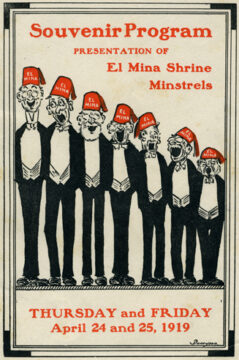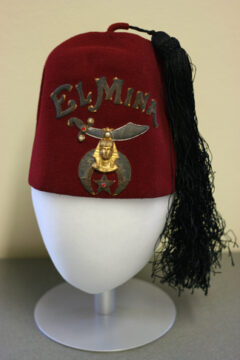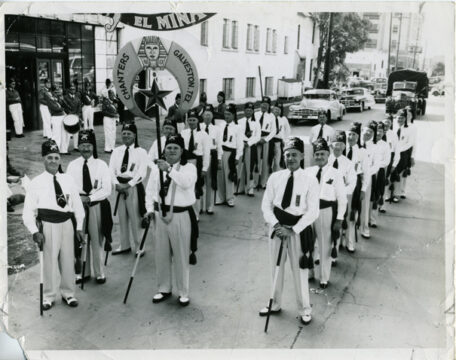
Have you ever been to a parade and seen men in funny red hats walking or riding small cars? If so, you may have seen members of a fraternal organization called the Shriners. During the month of January, the Rosenberg Library displayed an iconic Shriners’ fez, along with other memorabilia as the Treasure of the Month.

A Fraternity is Born
The Shriners trace their roots to 1870 when two fun-loving Masons, Dr. Walter M. Fleming and William “Billy” Florence expressed a desire to start a new fraternity for Masons centered on fun and fellowship. Together the two men founded the Ancient Arabic Order of the Nobles of the Mystic Shrine. The first meeting was held September 26, 1872. Membership to the organization is limited to Master Masons. As word of the new group spread, membership grew rapidly across the US, Canada, Mexico, and Panama by the early twentieth century. Galvestonians lobbied for a lodge in 1887, 1890 and 1892, but were denied by the state’s mother temple. So in 1902 delegates from Galveston lobbied the imperial council in San Francisco, and were granted a charter.
Galveston’s temple, called El Mina, held its first meeting July 2, 1902. Two years later the El Mina Shriner Band was founded to “put a little more of the “boom, boom” into the proceedings” as a May 1923 Galveston Tribune article put it. Paul Naschke, a well-known Galveston photographer, is credited with founding the band which made frequent appearances in parades and public events. By 1910 the group played in Havana, New Orleans, and Rochester, New York. The band remained popular for many years.
As membership in El Mina grew, the group sought out a space of their own. In 1928 they purchased Ashton Villa, formerly the J.M. Brown residence, at 2328 Broadway for their temple. They made substantial changes to the building including tearing down the kitchen, building a ballroom, removing a wall on the second floor for a billiard room, and removing walls on the third floor for a band rehearsal hall. In 1970 it was taken over by the Galveston Historical Foundation who opened it to the public four years later.

The History of the Fez
The fez is the most recognizable symbols of the Shriners. Lore states that William Florence had been to a party thrown by an Arabian diplomat in France, and was so drawn to the exotic culture he adopted its head gear for the new organization. Named for the city in Morocco where it’s produced, the fez on display has the local temple’s name “El Mina” in gold letters. It also features an iconic emblem called the “Jewel of the Order.” Like most things Masionic the emblem is full of symbolism. It consists of a scimitar which represents the members of the fraternity, the two claws are for fraternity and philanthropy, the sphinx for the governing body of the Shriners (the Masons), and the star hanging beneath it which represents the children helped by the organization every year. Shriners were instructed to take great care of their fez because of its reflection on the organization. A 1924 program reads:
Does the Shriner prize his fez? If he values it as value it he should, he will never take it where he would not take his own mother.
Good Works
Beyond neat hats, good music and social engagements, the Shriners of El Mina are best known for their dedication to helping countless children. Starting in the 1920s the Shriners began a network of hospitals for children whose families could not afford costly medical treatments. The first hospital in the system opened in 1922 in Shreveport, Louisiana to provide pediatric orthopedic care.
In 1962 the Shriners of North America allocated $10 million to establish three hospitals that specialized in treating burn victims. In March of 1968 the Shriner’s Burn Hospital opened its doors, and has since expanded its mission to provide care to children with neuromusculoskeletal conditions and other special healthcare needs, provide for the education of physicians and other healthcare professionals, and conduct research to improve the quality of care and life for patients and their families. Their mission is carried out without regard to race, color, creed, sex or sect, disability, national origin or ability of a patient or family to pay.
